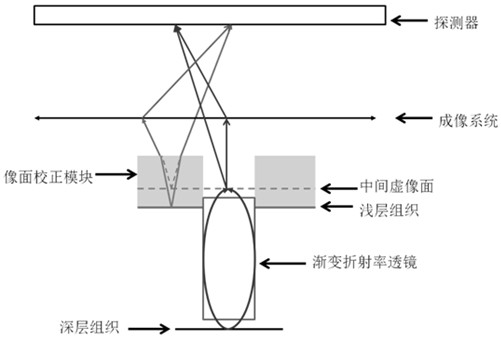Multiplane Microscopic Imaging System Based on Gradient Variable Index Lens
A gradient variable refractive index and microscopic imaging technology, which is applied in microscopes, instruments, optics, etc., can solve the problems of inability to obtain information on the fine structure of brain tissue, inability to image, and limited imaging speed, etc., to achieve rapid multi-plane imaging at any depth The effect of microscopic imaging
- Summary
- Abstract
- Description
- Claims
- Application Information
AI Technical Summary
Problems solved by technology
Method used
Image
Examples
specific Embodiment 1
[0060] figure 2 According to an embodiment of the present invention, it is a principle diagram of an arbitrary-depth multi-plane wide-field microscopic imaging light based on a gradient variable refractive index lens, which is suitable for realizing multi-plane imaging for simultaneous observation of the hippocampus and cortical surface, and the gradient variable refraction The scene where the length of the power lens is greater than the depth of the tissue in the observation area.
[0061] Specifically, such as figure 2 As shown, the deep hippocampus tissue is mapped to the virtual image plane through the gradient variable refractive index lens, and the shallow tissue is also mapped to the same virtual image plane through the BK7 glass column. Such as image 3 As shown, the observation depth from the superficial layer of the brain tissue to the deep hippocampus is 1.5 mm. The gradient index lens has a diameter of 0.5mm and a length of 2mm. The cover glass has a diameter...
specific Embodiment 2
[0063] Figure 4 It is a principle diagram of another kind of arbitrary depth multi-plane wide-field microscopic imaging light based on gradient variable refractive index lens provided according to an embodiment of the present invention, which is suitable for realizing multi-plane imaging of simultaneous observation of hippocampus and cortical surface, and the gradient changes Scenarios in which the length of the refractive index lens is less than the depth of the tissue in the observation area.
[0064] Specifically, such as Figure 4 As shown, the deep hippocampus tissue is mapped to the virtual image plane 1 through the gradient variable refractive index lens and then mapped to the virtual image plane 2 through the BK7 glass column. At this time, the position of the virtual image plane 2 is consistent with that of the cortex. Such as Figure 5 As shown, the observation depth of the brain tissue from the superficial layer to the deep hippocampus was 1.5 mm. The gradient ...
PUM
 Login to View More
Login to View More Abstract
Description
Claims
Application Information
 Login to View More
Login to View More - R&D
- Intellectual Property
- Life Sciences
- Materials
- Tech Scout
- Unparalleled Data Quality
- Higher Quality Content
- 60% Fewer Hallucinations
Browse by: Latest US Patents, China's latest patents, Technical Efficacy Thesaurus, Application Domain, Technology Topic, Popular Technical Reports.
© 2025 PatSnap. All rights reserved.Legal|Privacy policy|Modern Slavery Act Transparency Statement|Sitemap|About US| Contact US: help@patsnap.com



